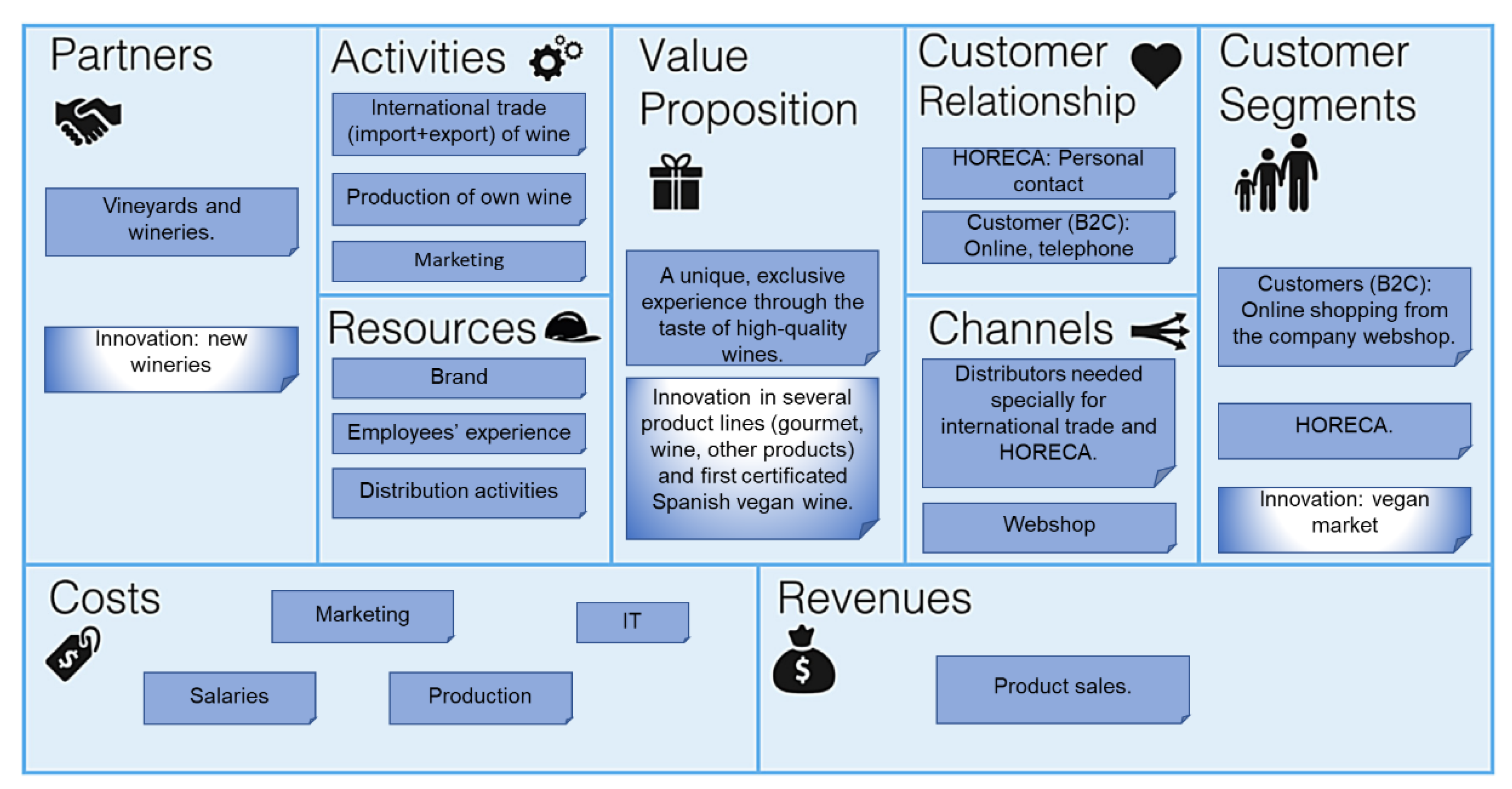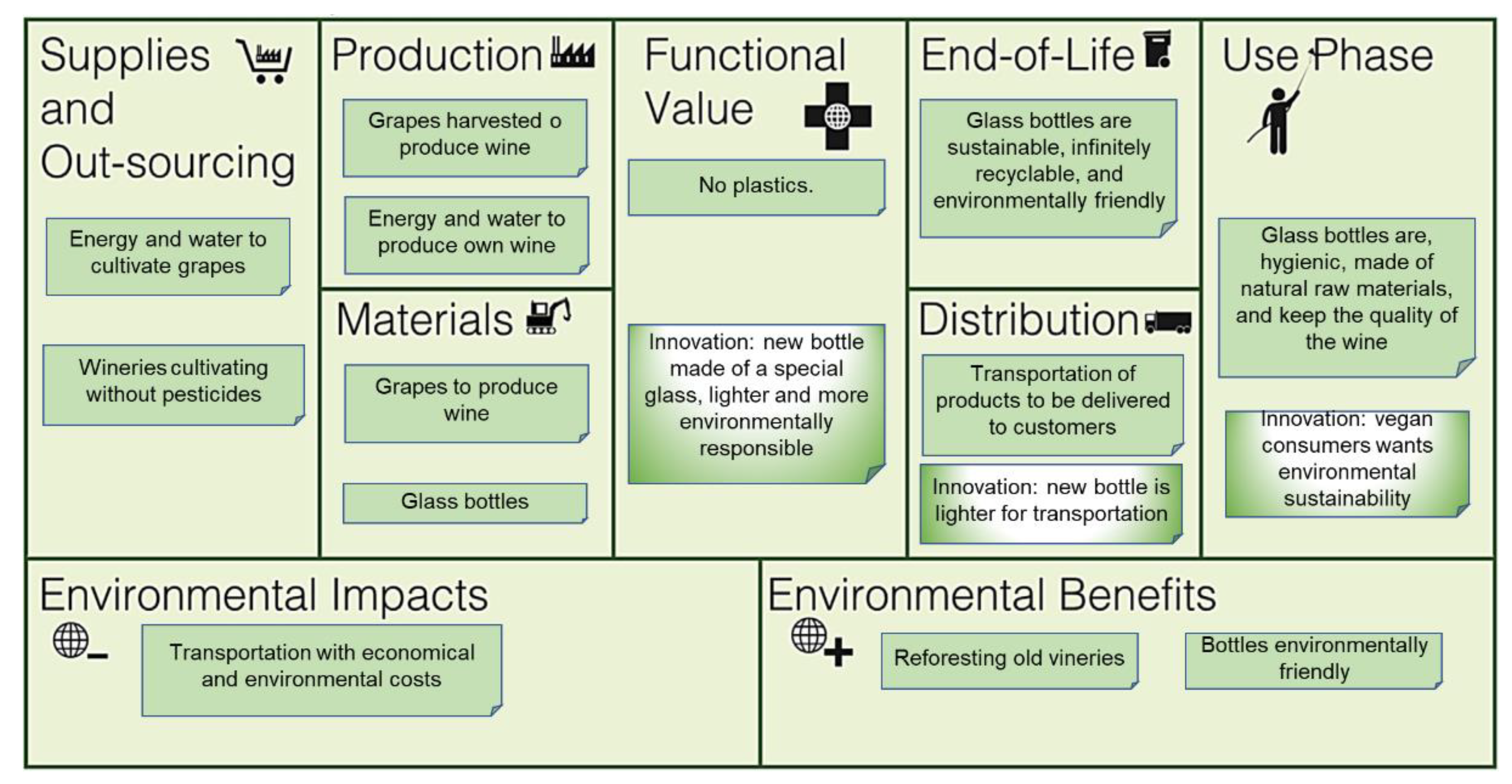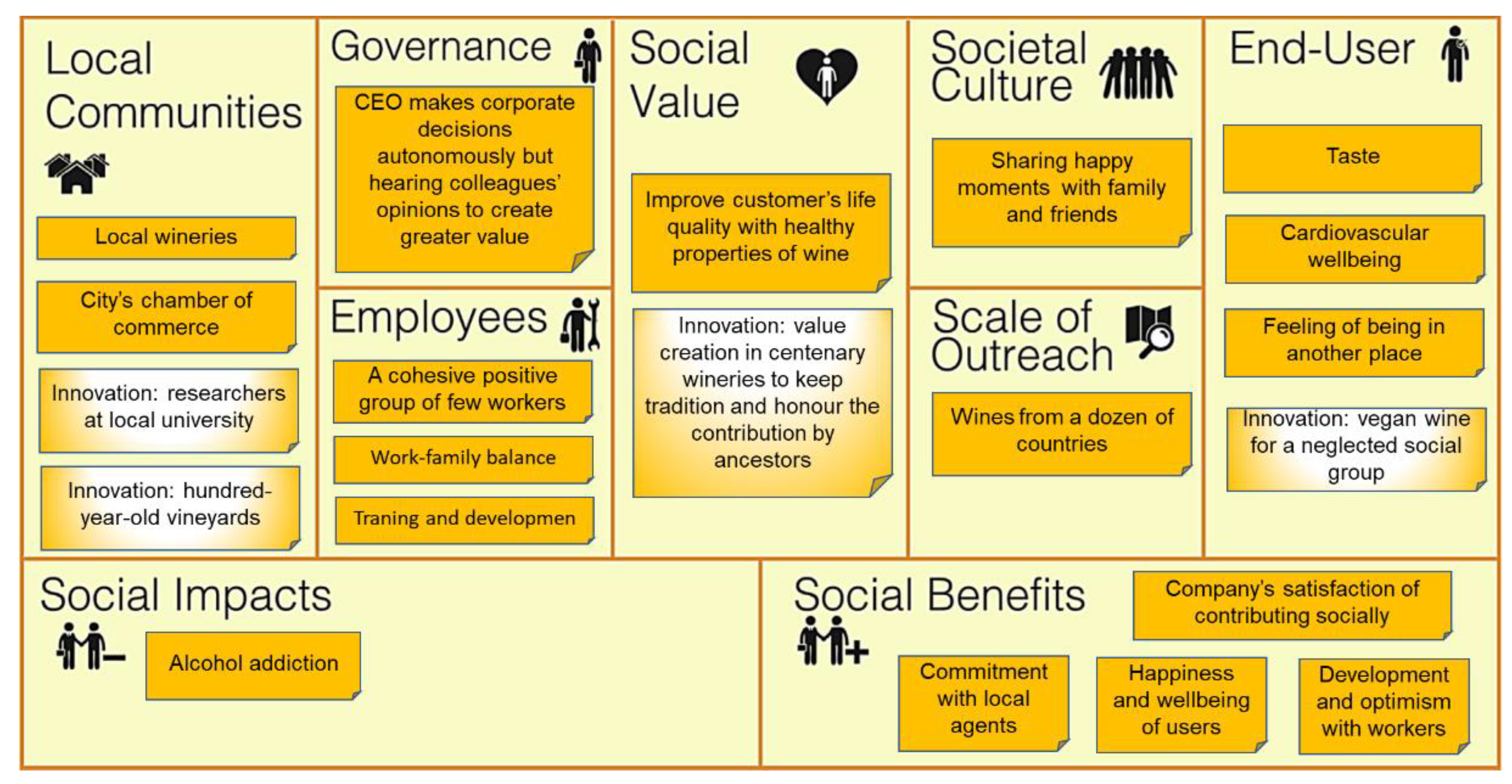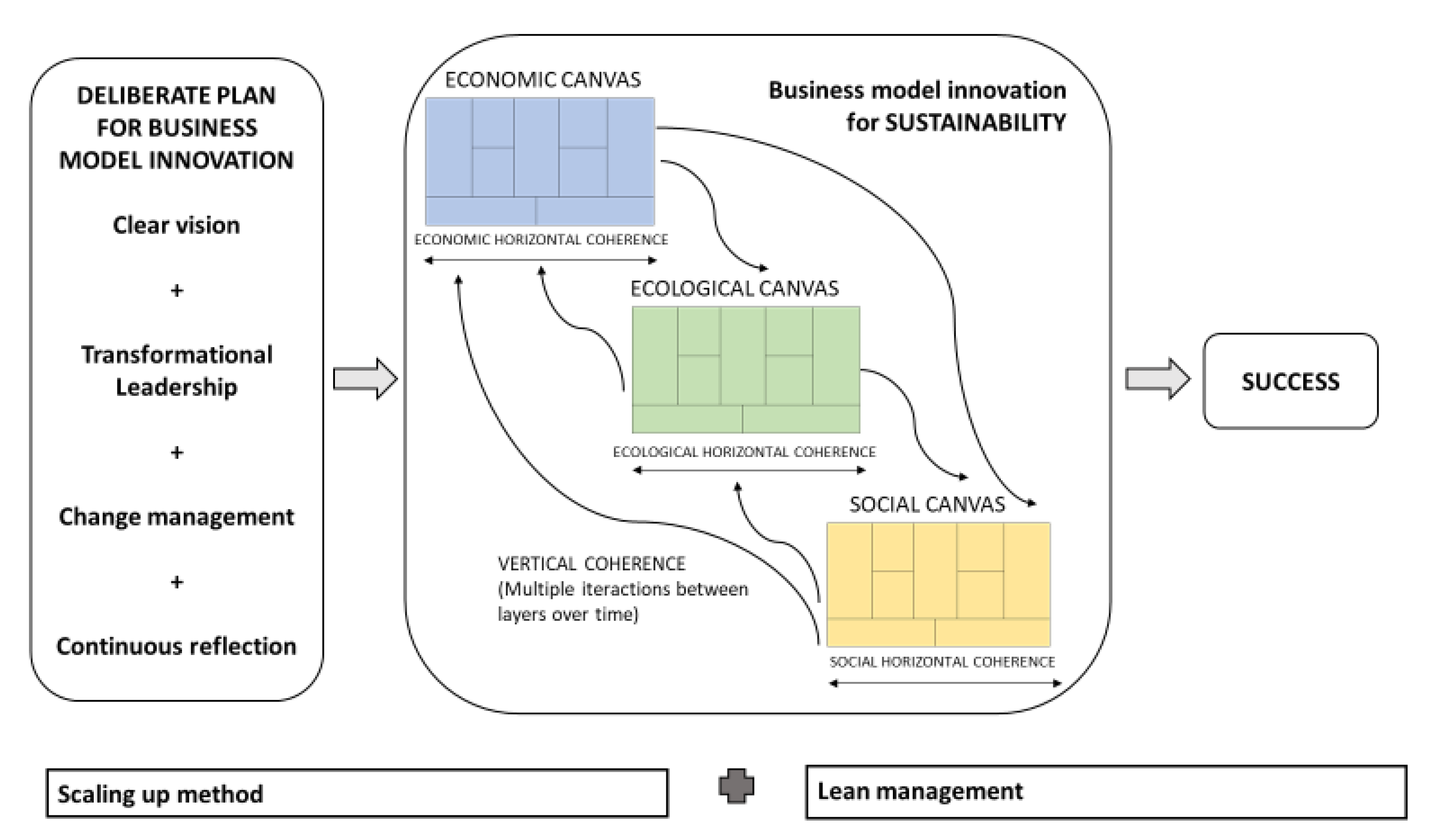Towards Sustainable Innovative Business Models
Abstract
1. Introduction
2. Theoretical Background
2.1. Business Model Innovation for Sustainability
2.2. Environmental and Social Issues for Sustainability
3. Materials and Methods
4. Results
…There are many competitors in this sector, especially in the production sector. However, the company has a lot of experience in the wine sector. I have been working for many years in this industry before creating my own company.
…Despite the Covid-19 pandemic, we had a very good year, much better than our competitors because of our multifocal approach. In 2020, the company’s sales increased.
4.1. Research Question 1: How Do Firms Innovate Their Business Models to Deal with the Economic, Environmental and Social Aspects of Sustainability and Their Interconnections?
…We became unique.
…After the business model innovation process, we are better able to identify innovation opportunities, commit resources to new courses of action. In fact, the new segment also brought the opportunity to increase the number of product lines.
…Vegan consumers seem to be more motivated by sustainability, by preserving nature from animals.
…We already sell organic wine provided by a winery in Jumilla using no pesticides. Currently, we are starting a collaboration with the local university for developing a certificate of non-genetically modified wine which is promising for the European wine industry and market.
We help employees in balancing work-family life, support regular training of the workers in new technologies and activities. For instance, we are now using lean management among office employees, and before the implementation, workers were trained in this way of doing things.
4.2. Research Question 2: How Do Managers Design the Process toward More Sustainable Innovative Business Models?
The changes mentioned are management decisions, I take all these types of decisions, as they are strategic, in economic terms, any approach that may arise, I devise it and then I look at it tactically and in terms of implementation with each person responsible for the affected area to see if it is viable. It must be like this, even if we are few, as it implies more work for each area and I always have to see if it can be implemented or not, the current structure of the company is tight in terms of personnel, as the budgets are tight from one year to the next.
…If I need to introduce any of the changes mentioned that involve more people, they are normally changes that do not automatically result in direct sales and therefore these jobs are not clearly amortized until after a time when these changes are reflected in the company’s results.
…Lately I am especially wondering how will the company be in the future? What do we want to be when we grow up?.
The company is not an NGO, but in our case, the management is clear that being updated in terms of ecological, social, etc. is a necessary and an advantage to be shown as a current company and with projection, in addition, we work with large customers in which we have to be aligned in these terms. Furthermore, what we explain at the University, and what I put a lot of emphasis on with the kids, which is Marketing that is concerned not only with the consumer but with society as a whole, is going to be key for companies in the medium term. The consumer is going to force all companies to make this adaptation, the first large companies to implement it are the big ones, and then behind them, whether they are convinced or not, the SMEs will follow suit. It is a change produced mainly by the incessant growth of consumer power in their ability to give their opinion and co-create products and services thanks to the technological change of the digitalization of the economy.
…Last year we began to use lean management among the five office employees, and it is working so well.
….After the business model innovation process, we are better able to identify innovation opportunities, commit resources to new courses of action.
….The scaling up method we usually trust on is a bit limited with regards to the ecological and social aspects pursued by a company like most, looking for profit.
5. Discussion, Implications and Future Research
5.1. Findings Discussion
5.2. Implications
5.3. Future Research Directions
Author Contributions
Funding
Institutional Review Board Statement
Informed Consent Statement
Data Availability Statement
Conflicts of Interest
References
- Cosenz, F.; Bivona, E. Fostering growth patterns of SMEs through business model innovation. A tailored dynamic business modelling approach. J. Bus. Res. 2021, 130, 658–669. [Google Scholar] [CrossRef]
- Teece, D.J. Business Models, Business Strategy and Innovation. Long Range Plan. 2010, 43, 172–194. [Google Scholar] [CrossRef]
- Foss, N.J.; Saebi, T. Fifteen Years of Research on Business Model Innovation: How far have we come, and where should we go? J. Manag. 2017, 43, 200–227. [Google Scholar] [CrossRef]
- Epstein, M.; Buhovac, A.; Elkington, J.; Leonard, H. Making Sustainability Work: Best Practices in Managing and Measuring Corporate Social, Environmental, and Economic Impacts; Berrett-Koehler Publishers: San Francisco, CA, USA, 2017. [Google Scholar] [CrossRef]
- Bocken, N.; Weissbrod, I.; Antikainen, M. Business experimentation for sustainability: Emerging perspectives. J. Clean. Prod. 2021, 281, 124904. [Google Scholar] [CrossRef]
- Boons, F.; Luedeke-Freund, F. Business models for sustainable innovation: State-of-the-art and steps towards a research agenda. J. Clean. Prod. 2013, 45, 9–19. [Google Scholar] [CrossRef]
- Le Breton-Miller, I.; Miller, D. Family firms and practices of sustainability: A contingency view. J. Fam. Bus. Strat. 2016, 7, 26–33. [Google Scholar] [CrossRef]
- Geissdoerfer, M.; Vladimirova, D.; Evans, S. Sustainable business model innovation: A review. J. Clean. Prod. 2018, 198, 401–416. [Google Scholar] [CrossRef]
- Velter, M.G.E.; Bitzer, V.; Bocken, N.M.P.; Kemp, R. Sustainable business model innovation: The role of boundary work for multi-stakeholder alignment. J. Clean. Prod. 2020, 247, 119497. [Google Scholar] [CrossRef]
- Meroño-Cerdán, A.L.; López-Nicolás, C.; Molina-Castillo, F.J. Risk aversion, innovation and performance in family firms. Econ. Innov. New Technol. 2018, 27, 189–203. [Google Scholar] [CrossRef]
- Evans, S.; Fernando, L.; Yang, M.Y. Sustainable Value Creation-From Concept Towards Implementation. In Sustainable Manufacturing: Challenges, Solutions and Implementation Perspectives; Stark, R., Seliger, G., Bonvoisin, J., Eds.; Springer International Publishing AG: Cham, Switzerland, 2017; pp. 203–220. [Google Scholar] [CrossRef]
- Evans, S.; Vladimirova, D.; Holgado, M.; Van Fossen, K.; Yang, M.; Silva, E.A.; Barlow, C.Y. Business Model Innovation for Sustainability: Towards a Unified Perspective for Creation of Sustainable Business Models. Bus. Strat. Environ. 2017, 26, 597–608. [Google Scholar] [CrossRef]
- Joyce, A.; Paquin, R.L. The triple layered business model canvas: A tool to design more sustainable business models. J. Clean. Prod. 2016, 135, 1474–1486. [Google Scholar] [CrossRef]
- Osterwalder, A.; Pigneur, Y. Business Model Generation: A Handbook for Visionaries, Game Changers, and Challengers; John Wiley & Sons: Hoboken, NJ, USA, 2010. [Google Scholar]
- Hart, S.; Milstein, M. Creating Sustainable Value. Acad. Manag. Exec. 2003, 17, 56–67. [Google Scholar] [CrossRef]
- Lüdeke-Freund, F. Towards a Conceptual Framework of Business Models for Sustainability. In Knowledge Collaboration & Learning for Sustainable Innovation, Proceedings of the ERSCP-EMSU Conference 2010, Delft, The Netherlands, 25–29 October 2010; Wever, R., Quist, J., Tukker, A., Woudstra, J., Boons, F., Beute, N., Eds.; Available online: https://ssrn.com/abstract=2189922 (accessed on 19 February 2019).
- Wirtz, B.W. Business Model Management: Design, Process, Instruments; Springer: Cham, Switzerland, 2020. [Google Scholar]
- Bocken, N.; Pauw, I.; Bakker, C.A.; van der Grinten, B. Product design and business model strategies for a circular economy. J. Ind. Prod. Eng. 2016, 33, 308–320. [Google Scholar] [CrossRef]
- Matzembacher, D.E.; Raudsaar, M.; De Barcellos, M.D.; Mets, T. Business Models’ Innovations to Overcome Hybridity-Related Tensions in Sustainable Entrepreneurship. Sustainability 2020, 12, 4503. [Google Scholar] [CrossRef]
- Breuer, H.; Fichter, K.; Freund, F.L.; Tiemann, I. Sustainability-oriented business model development: Principles, criteria and tools. Int. J. Entrep. Ventur. 2018, 10, 256–286. [Google Scholar] [CrossRef]
- Sinkovics, N. Pattern Matching in Qualitative Analysis. In The SAGE Handbook of Qualitative Business and Management Research Methods; SAGE Publications Ltd.: Thousand Oaks, CA, USA, 2018; pp. 468–485. [Google Scholar] [CrossRef]
- Bouncken, R.B.; Qiu, Y.; Sinkovics, N.; Kürsten, W. Qualitative research: Extending the range with flexible pattern matching. Rev. Manag. Sci. 2021, 15, 251–273. [Google Scholar] [CrossRef]
- Velu, C. Business model innovation and third-party alliance on the survival of new firms. Technovation 2015, 35, 1–11. [Google Scholar] [CrossRef]
- Pieroni, M.P.; McAloone, T.C.; Pigosso, D.C. Business model innovation for circular economy and sustainability: A review of approaches. J. Clean. Prod. 2019, 215, 198–216. [Google Scholar] [CrossRef]
- Hamelink, M.; Opdenakker, R. How business model innovation affects firm performance in the energy storage market. Renew. Energy 2019, 131, 120–127. [Google Scholar] [CrossRef]
- Schaltegger, S.; Freund, F.L.; Hansen, E.G. Business cases for sustainability: The role of business model innovation for corporate sustainability. Int. J. Innov. Sustain. Dev. 2012, 6, 95–119. [Google Scholar] [CrossRef]
- Penrose, E.T. The Theory of the Growth of the Firm; Basil Blackwell: Oxford, UK, 1959. [Google Scholar]
- Zollo, M.; Winter, S.G. Deliberate Learning and the Evolution of Dynamic Capabilities. Organ. Sci. 2002, 13, 339–351. [Google Scholar] [CrossRef]
- Hart, S.L.; Sharma, S. Engaging fringe stakeholders for competitive imagination. Acad. Manag. Perspect. 2004, 18, 7–18. [Google Scholar] [CrossRef]
- Bocken, N.M. Sustainable venture capital–catalyst for sustainable start-up success? J. Clean. Prod. 2015, 108, 647–658. [Google Scholar] [CrossRef]
- Stubbs, W.; Cocklin, C. Conceptualizing a “Sustainability Business Model”. Organ. Environ. 2008, 21, 103–127. [Google Scholar] [CrossRef]
- Bocken, N.M.P.; Short, S.W.; Rana, P.; Evans, S. A literature and practice review to develop sustainable business model archetypes. J. Clean. Prod. 2014, 65, 42–56. [Google Scholar] [CrossRef]
- Porter, M.E.; Kramer, M.R. Strategy and society: The link between competitive advantage and corporate social responsibility. Harv. Bus. Rev. 2006, 84, 78–92. [Google Scholar] [PubMed]
- Elkington, J. Cannibals with Forks: The Triple Bottom Line of 21st Century Business; Capstone: Oxford, UK, 1997; ISBN 1-900961-27-X. [Google Scholar]
- Hahn, R.; Spieth, P.; Ince, I. Business model design in sustainable entrepreneurship: Illuminating the commercial logic of hybrid businesses. J. Clean. Prod. 2018, 176, 439–451. [Google Scholar] [CrossRef]
- Winn, M.; Kirchgeorg, M. The siesta is over: A rude awakening from sustainability myopia. Corp. Environ. Strategy Compet. Advant. 2005, 3, 232–258. [Google Scholar] [CrossRef]
- Ritala, P.; Huotari, P.; Bocken, N.; Albareda, L.; Puumalainen, K. Sustainable business model adoption among S&P 500 firms: A longitudinal content analysis study. J. Clean. Prod. 2018, 170, 216–226. [Google Scholar] [CrossRef]
- Yip, A.W.H.; Bocken, N.M.P. Sustainable business model archetypes for the banking industry. J. Clean. Prod. 2018, 174, 150–169. [Google Scholar] [CrossRef]
- Geissdoerfer, M.; Morioka, S.N.; de Carvalho, M.M.; Evans, S. Business models and supply chains for the circular economy. J. Clean. Prod. 2018, 190, 712–721. [Google Scholar] [CrossRef]
- Lüdeke-Freund, F.; Dembek, K. Sustainable business model research and practice: Emerging field or passing fancy? J. Clean. Prod. 2017, 168, 1668–1678. [Google Scholar] [CrossRef]
- Gao, P.; Li, J.Y. Understanding sustainable business model: A framework and a case study of the bike-sharing industry. J. Clean. Prod. 2020, 267, 122229. [Google Scholar] [CrossRef]
- Bocken, N.; Strupeit, L.; Whalen, K.; Nußholz, J. A Review and Evaluation of Circular Business Model Innovation Tools. Sustainability 2019, 11, 2210. [Google Scholar] [CrossRef]
- Hall, J.; Vredenburg, H. The challenges of innovating for sustainable development. MIT Sloan Manag. Rev. 2003, 45, 61–68. [Google Scholar]
- Wagner, M. Integration of Environmental Management with Other Managerial Functions of the Firm. Empirical Effects on Drivers of Economic Performance. Long Range Plan. 2007, 40, 611–628. [Google Scholar] [CrossRef]
- Burke, L.; Logsdon, J.M. How corporate social responsibility pays off. Long Range Plan. 1996, 29, 495–502. [Google Scholar] [CrossRef]
- Mont, O.K. Clarifying the concept of product–service system. J. Clean. Prod. 2002, 10, 237–245. [Google Scholar] [CrossRef]
- Tukker, A. Product services for a resource-efficient and circular economy—A review. J. Clean. Prod. 2015, 97, 76–91. [Google Scholar] [CrossRef]
- Shakeel, J.; Mardani, A.; Chofreh, A.G.; Goni, F.A.; Klemes, J.J. Anatomy of sustainable business model innovation. J. Clean. Prod. 2020, 261, 121201. [Google Scholar] [CrossRef]
- You, W.; Chen, W.; Agyapong, M.; Mordi, C. The business model of Do-It-Yourself (DIY) laboratories—A triple-layered perspective. Technol. Forecast. Soc. Chang. 2020, 159, 120205. [Google Scholar] [CrossRef]
- Birkin, F.; Polesie, T.; Lewis, L. A new business model for sustainable development: An exploratory study using the theory of constraints in Nordic organizations. Bus. Strat. Environ. 2009, 18, 277–290. [Google Scholar] [CrossRef]
- Hall, J.; Wagner, M. Integrating Sustainability into Firms’ Processes: Performance Effects and the Moderating Role of Business Models and Innovation. Bus. Strat. Environ. 2012, 21, 183–196. [Google Scholar] [CrossRef]
- Antikainen, M.; Aminoff, A.; Heikkilä, J. Business model experimentations in advancing B2B sharing economy research. In ISPIM Innovation Symposium; The International Society for Professional Innovation Management (ISPIM): Manchester, UK, 2018; pp. 1–12. [Google Scholar]
- Seiffert, M.; Loch, C. Systemic thinking in environmental management: Support for sustainable development. J. Clean. Prod. 2005, 13, 1197–1202. [Google Scholar] [CrossRef]
- Markard, J.; Raven, R.; Truffer, B. Sustainability transitions: An emerging field of research and its prospects. Res. Policy 2012, 41, 955–967. [Google Scholar] [CrossRef]
- Schaltegger, S.; Wagner, M. Sustainable entrepreneurship and sustainability innovation: Categories and interactions. Bus. Strat. Environ. 2011, 20, 222–237. [Google Scholar] [CrossRef]
- Ambec, S.; Lanoie, P. Does It Pay to be Green? A Systematic Overview. Acad. Manag. Perspect. 2008, 22, 45–62. Available online: https://www.jstor.org/stable/27747478 (accessed on 28 November 2020).
- Schot, J.; Geels, F.W. Strategic niche management and sustainable innovation journeys: Theory, findings, research agenda, and policy. Technol. Anal. Strat. Manag. 2008, 20, 537–554. [Google Scholar] [CrossRef]
- AlMahmoud, E.; Doloi, H.K. Assessment of Social Sustainability in Construction Projects Using Social Network Analysis. J. Int. Bus. Res. Mark. 2018, 3, 35–46. [Google Scholar] [CrossRef]
- Zhao, X.; Hwang, B.-G.; Lu, Q. Typology of business model innovations for delivering zero carbon buildings. J. Clean. Prod. 2018, 196, 1213–1226. [Google Scholar] [CrossRef]
- Pan, W.; Ning, Y. The dialectics of sustainable building. Habitat Int. 2015, 48, 55–64. [Google Scholar] [CrossRef]
- Rowley, J. Using case studies in research. Manag. Res. News 2002, 25, 16–27. [Google Scholar] [CrossRef]
- Eisenhardt, K.M. Building Theories from Case Study Research. Acad. Manag. Rev. 1989, 14, 532–550. [Google Scholar] [CrossRef]
- Yin, R.K. Case Study Research and Applications: Design and Methods; SAGE Publications: Thousand Oaks, CA, USA, 2017. [Google Scholar]
- Voss, C.; Tsikriktsis, N.; Frohlich, M. Case research in operations management. Int. J. Oper. Prod. Manag. 2002, 22, 195–219. [Google Scholar] [CrossRef]
- Siggelkow, N. Persuasion With Case Studies. Acad. Manag. J. 2007, 50, 20–24. [Google Scholar] [CrossRef]
- Paul, J. Between-method triangulation in organizational diagnosis. Int. J. Organ. Anal. 1996, 4, 135–153. [Google Scholar] [CrossRef]
- Leonard-Barton, D. A Dual Methodology for Case Studies: Synergistic Use of a Longitudinal Single Site with Replicated Multiple Sites. Organ. Sci. 1990, 1, 248–266. [Google Scholar] [CrossRef]
- Taran, Y.; Boer, H.; Lindgren, P. A Business Model Innovation Typology. Decis. Sci. 2015, 46, 301–331. [Google Scholar] [CrossRef]
- Bringer, J.D.; Johnston, L.H.; Brackenridge, C.H. Maximizing Transparency in a Doctoral Thesis1: The Complexities of Writing About the Use of QSR*NVIVO Within a Grounded Theory Study. Qual. Res. 2004, 4, 247–265. [Google Scholar] [CrossRef]
- Gioia, D.A.; Corley, K.G.; Hamilton, A.L. Seeking Qualitative Rigor in Inductive Research: Notes on the Gioia methodology. Organ. Res. Methods 2013, 16, 15–31. [Google Scholar] [CrossRef]
- Harnish, V. Scaling Up: How a Few Companies Make It… and Why the Rest Don’t; Gazelles Inc.: Asburn, VA, USA, 2014. [Google Scholar]
- Hacklin, F.; Björkdahl, J.; Wallin, M.W. Strategies for business model innovation: How firms reel in migrating value. Long Range Plan. 2018, 51, 82–110. [Google Scholar] [CrossRef]
- Brannon, D.L.; Wiklund, J. An Analysis of Business Models: Firm characteristics, innovation and performance. Acad. Entrep. J. 2016, 22, 1–20. [Google Scholar]
- Da Silva, C.M.; Trkman, P. Business Model: What It Is and What It Is Not. Long Range Plan. 2014, 47, 379–389. [Google Scholar] [CrossRef]
- Priyono, A.; Moin, A.; Putri, V.N.A.O. Identifying Digital Transformation Paths in the Business Model of SMEs during the COVID-19 Pandemic. J. Open Innov. Technol. Mark. Complex. 2020, 6, 104. [Google Scholar] [CrossRef]
- Svensson, G.; Ferro, C.; Høgevold, N.; Padin, C.; Varela, J.C.S.; Sarstedt, M. Framing the triple bottom line approach: Direct and mediation effects between economic, social and environmental elements. J. Clean. Prod. 2018, 197, 972–991. [Google Scholar] [CrossRef]
- Hechanova, R.M.; Cementina-Olpoc, R. Transformational Leadership, Change Management, and Commitment to Change: A Comparison of Academic and Business Organizations. Asia Pac. Educ. Res. 2013, 22, 11–19. [Google Scholar] [CrossRef]
- Liao, M.-H.; Wang, C.-T. Using Enterprise Architecture to Integrate Lean Manufacturing, Digitalization, and Sustainability: A Lean Enterprise Case Study in the Chemical Industry. Sustainability 2021, 13, 4851. [Google Scholar] [CrossRef]
- Lopez-Nicolas, C.; Nikou, S.; Molina-Castillo, F.-J.; Bouwman, H. Gender differences and business model experimentation in European SMEs. J. Bus. Ind. Mark. 2020, 35, 1205–1219. [Google Scholar] [CrossRef]





| Methodological approach | Qualitative exploratory research Content analysis Pattern marching |
| Technique | Case study |
| Number of cases | One |
| Case selection | Purposive sampling Theoretical sampling strategy |
| Field work | Interviews: February-April 2021 Secondary data: February–April 2021. |
| Primary source of information | In-depth interviews with the CEO |
| Instrument used | Case study protocol Semi-structured questionnaires |
| Number and duration of interviews | Three interviews 70 min, 53 min, 55 min. |
| Main topics of the interview | Economic business model and business model innovations Business model and business model innovation: ecological and social layers Interconnections between the three layers Process of decision making toward sustainable innovative business models |
| Setting and data collection | Interviews conducted at the workplace and videoconferencing Interview guide provided in advance Field notes by authors during and after interviews Additional/missing/incomplete information requested after the interviews |
| Data analysis | Authors classified, categorized and analyzed information Key informant participated by checking and combining perspectives with researchers |
| Secondary sources of information | Public data: website, presentations, press news, regional TV and radio media, events. Private data: sales volume, products catalogues, observation. |
Publisher’s Note: MDPI stays neutral with regard to jurisdictional claims in published maps and institutional affiliations. |
© 2021 by the authors. Licensee MDPI, Basel, Switzerland. This article is an open access article distributed under the terms and conditions of the Creative Commons Attribution (CC BY) license (https://creativecommons.org/licenses/by/4.0/).
Share and Cite
López-Nicolás, C.; Ruiz-Nicolás, J.; Mateo-Ortuño, E. Towards Sustainable Innovative Business Models. Sustainability 2021, 13, 5804. https://doi.org/10.3390/su13115804
López-Nicolás C, Ruiz-Nicolás J, Mateo-Ortuño E. Towards Sustainable Innovative Business Models. Sustainability. 2021; 13(11):5804. https://doi.org/10.3390/su13115804
Chicago/Turabian StyleLópez-Nicolás, Carolina, Jesús Ruiz-Nicolás, and Enrique Mateo-Ortuño. 2021. "Towards Sustainable Innovative Business Models" Sustainability 13, no. 11: 5804. https://doi.org/10.3390/su13115804
APA StyleLópez-Nicolás, C., Ruiz-Nicolás, J., & Mateo-Ortuño, E. (2021). Towards Sustainable Innovative Business Models. Sustainability, 13(11), 5804. https://doi.org/10.3390/su13115804






